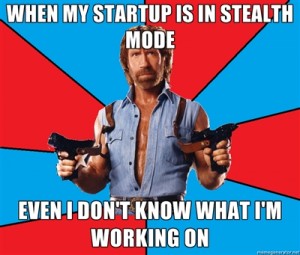Vinicius Vacanti is co-founder and CEO of Yipit. Next posts on how to acquire users for free and how to raise a Series A. Don’t miss them by subscribing via email or via twitter.
When we quit our jobs to start a new company, the first question we always got: “So, what are you working on?”
It’s actually a question I hated getting.
It puts you on the spot. You feel like you’re getting sized up. You have to justify to this person why you thought your idea was good enough to quit your job. Why this was going to be the next big thing and you’re the one that thought of it, not them.
Luckily, I had a quick answer: “Actually, we can’t really tell you. We’re in stealth mode.”
Why were we in “stealth mode”?
We had the same reason almost everyone else had, we didn’t want to awaken competitors or other entrepreneurs to our great new idea.
But, in retrospect, I know that, at least for me, it wasn’t the only reason.
We were in stealth mode not for fear of competition but of finding out our idea wasn’t very good.
You’ve quit your job. Your friends and family are behind you. Everyone’s waiting for what brilliant thing you’ve come up with. I mean, you quit your job, so it must be a really good idea. But, the truth is you’re not so sure it’s that brilliant. Somedays you think it’s great. Somedays you think it’s doomed.
So, instead of facing those fears, we could just say we were in “stealth mode”.
But, that fear sadly prevented us from having many important conversations with potential customers, investors, journalists, and other founders.
When we finally overcame those fears and started talking about our ideas, it was shocking how much a single conversation could impact the direction of our startup.
Letting go of “stealth mode” was one of the best decisions we made.
Overcoming the Fear
I’ve put the various fears of failure into buckets and how we overcame them:
- Fear of family, friends not liking our idea. We started thinking about our ideas as experiments and expressed them as such. While they were supportive of us, they were quick to give honest feedback on our ideas which became a valuable source of input. Especially valuable were other founders who gave us great advice on product and market.
- Fear of strangers not liking our idea. As we started thinking of our ideas as experiments, strangers became an excellent opportunity to practice our startup pitch and collect some feedback. You’d also be really surprised how random strangers may happen to know someone or something that can dramatically help your startup.
- Fear of potential customers not liking our idea. This is by far the worst fear. We quickly learned that customer feedback was an essential part of product development. A customer not liking our idea was a great source of learnings so that we could iterate to a better product instead of guessing for a year what people might want.
- Fear of an investor not liking our idea. We realized that talking to investors about our early ideas was a great way to develop a relationship. To be clear, it’s not about pitching them for money but for getting feedback. By the time our product started taking off, they already knew us and were impressed with our progress.
- Fear of a journalist not liking our idea. Journalists have way more stuff to do then find a bad product from a first-time founder and write about how no one should use it. It’s hard enough getting journalists to cover your startup when it’s good. Good luck trying to get them to write about it when it’s bad.
- Fear of competition. While this was more of a superficial fear, we realized that any good idea had many teams working on it at the same time. We were going to succeed because of our team and our approach and not because no one else was trying. We also became followers of the lean startup movement and our idea to prototype cycles went from months to days.
Unless you have an unbelievably good reason to be in “stealth mode” and it’s very unlikely you do, get out of it. You’re missing out, we did.
Vinicius Vacanti is co-founder and CEO of Yipit. Next posts on how to acquire users for free and how to raise a Series A. Don’t miss them by subscribing via email or via twitter.






